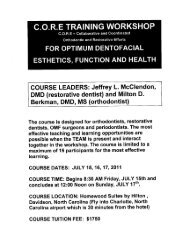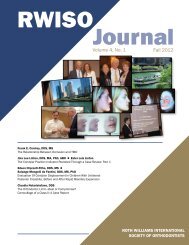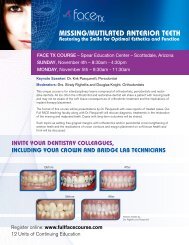2010 RWISO Journal - Roth Williams International Society of ...
2010 RWISO Journal - Roth Williams International Society of ...
2010 RWISO Journal - Roth Williams International Society of ...
You also want an ePaper? Increase the reach of your titles
YUMPU automatically turns print PDFs into web optimized ePapers that Google loves.
Figure 6-e Left lateral intraoral photograph in MIP showing<br />
class II molar relationship and retained deciduous canine.<br />
Figure 6-f Panoramic x-ray. The upper left canine showing<br />
root apex almost formed, but not erupted, due to lack <strong>of</strong> space.<br />
Figure 6-g Lateral cephalogram showing slightly<br />
retrusive mandible and protrusive upper incisors.<br />
Jarabak’s cephalometric analysis showed a strong counterclockwise<br />
growth tendency expressed in such measurements<br />
as a posterior facial height-anterior facial height ratio<br />
<strong>of</strong> 70%, a long ramus height in comparison to the posterior<br />
cranial base length, and a small Y-axis-to-SN angle (Table 1).<br />
60 Linton, Jung | The Effect <strong>of</strong> Tooth Wear on Postorthodontic Pain Patients: Part 2<br />
Table 1 Jarabak’s analysis <strong>of</strong> case 6 in January 2000.<br />
The maxillary arch was rapidly expanded with a fixed-<br />
type expander, which was retained for 6 months. Growth<br />
modification <strong>of</strong> the maxillary protrusion was accomplished<br />
simultaneously with a high-pull headgear for 10 months. The<br />
diagnostic study models mounted before and after headgear<br />
therapy clearly showed the effect <strong>of</strong> the growth modification<br />
treatment (Figure 7).<br />
Figure 7 Mounted models <strong>of</strong> the case before and after the<br />
first phase <strong>of</strong> growth modification treatment. The models were<br />
mounted on a semiadjustable articulator with estimated<br />
face-bow transfer and with centric relation bite registration<br />
records. The class II relationship <strong>of</strong> the first molars (blue lines)<br />
in January 2001, was improved compared to the molar<br />
relationship <strong>of</strong> the case in January 2000.<br />
Subsequent to headgear therapy, the four first premolars<br />
were extracted, and the patient received fixed-appliance<br />
therapy for the following 20 months. Class I canine and<br />
molar relationships were achieved with maximum anchorage<br />
in the upper arch and moderate anchorage in the lower<br />
arch in December 2002. The patient’s facial appearance was








